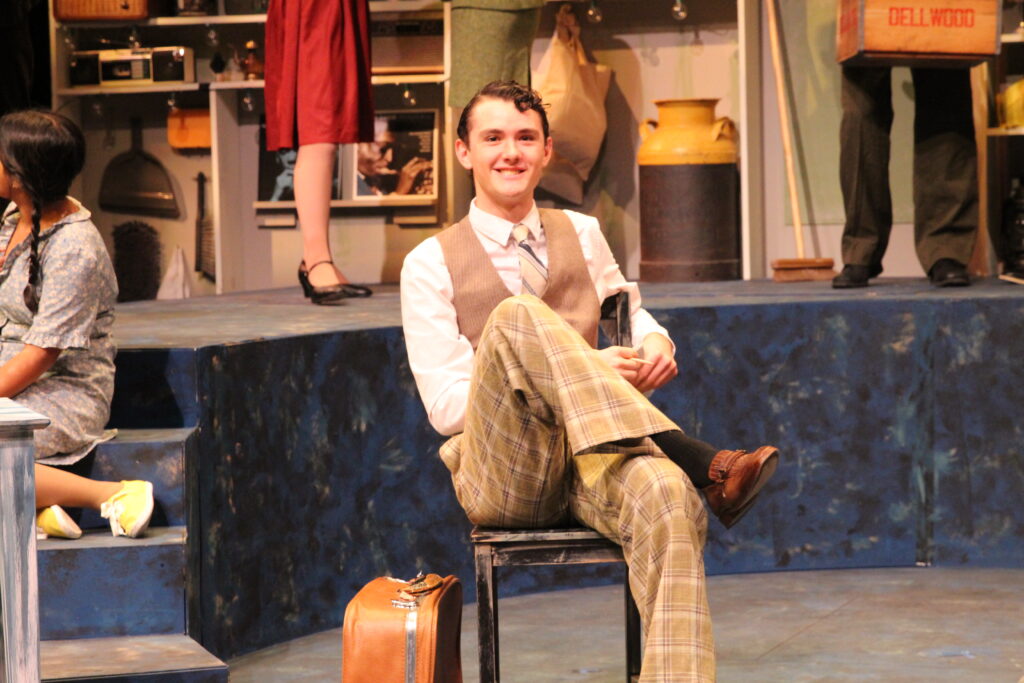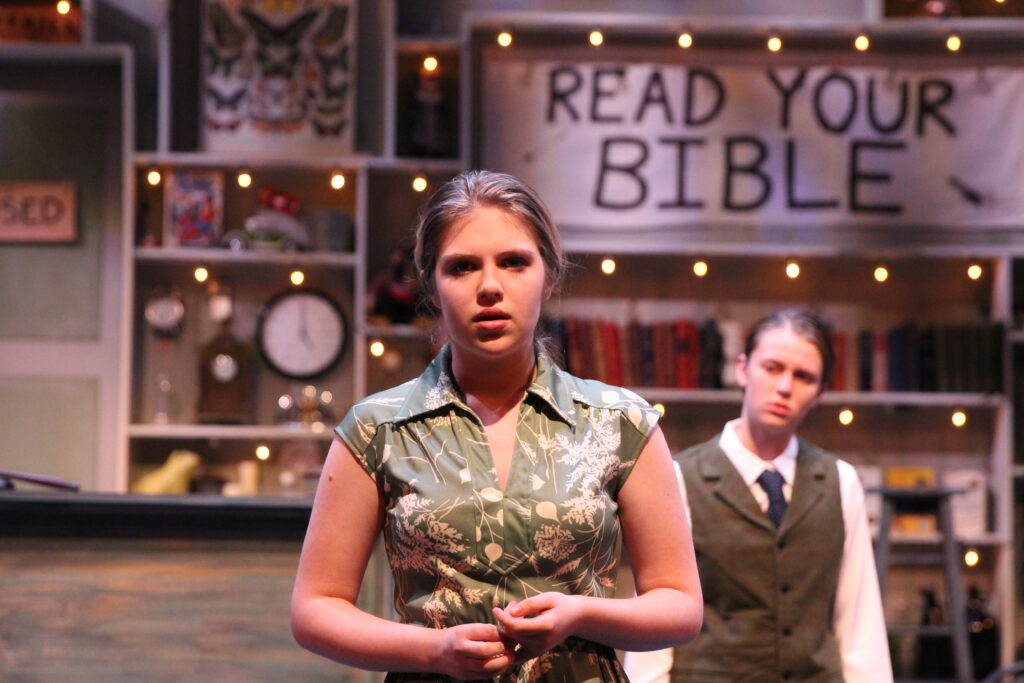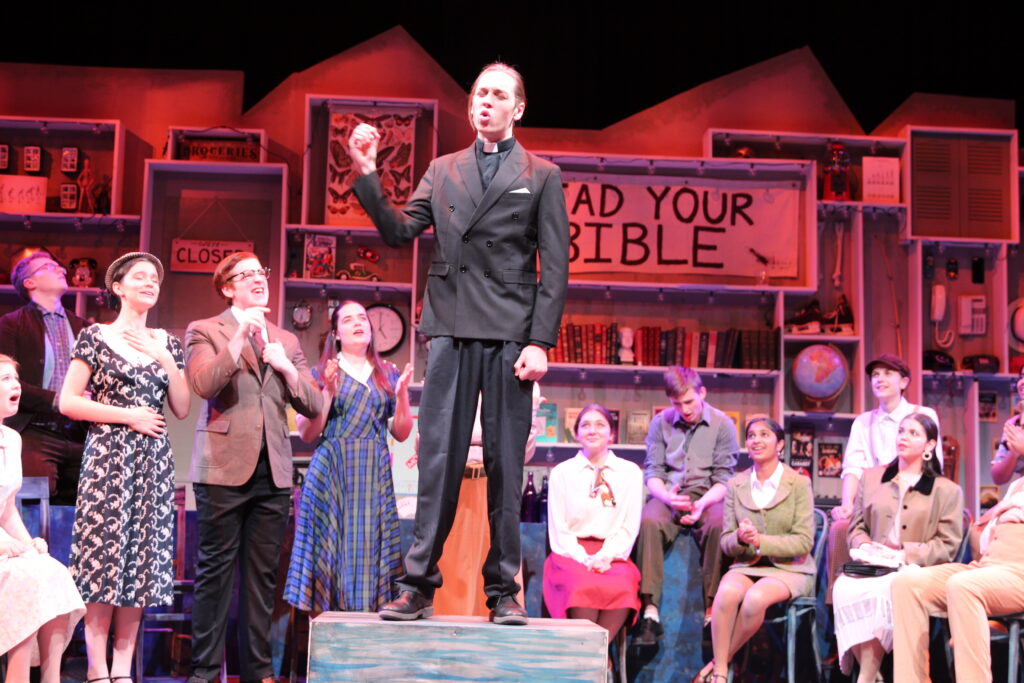Photo: Henry Barnes (sitting) and Gavin Tieken-Zidel (standing right) were the leads in Belmont High School Performing Arts Company’s production of “Inherit The Wind.”
Belmont High School Performing Arts Company Presented “INHERIT THE WIND” by Jerome Lawrence and Robert E. Lee at Belmont Middle and High School Black Box.
The Performing Arts Company Fall Play was the classic drama, “Inherit the Wind,” based on the real-life story of the 1925 Scopes Monkey Trial, when a high school science teacher was arrested for teaching evolution and violating a new state law. The play tells the tale of a small town gripped in the ensuing debate about science, religion, free speech, the law, and the two legal heavyweights coming to town to battle for their causes.
The show features a cast of 18 actors and the tech crew includes more than 40 students working on lighting, scenery, costumes, props, sound, and stage management.
NOTES ABOUT THE SHOW FROM PRODUCTION DRAMATURG LUCAS HOLMAN:
A dramaturg serves as a literary expert for a theatrical production, providing historical research, analysis and interpretation of a play to the cast, crew, and audience. For Inherit the Wind, Junior Lucas Holman conducted research about the history of the play, which was presented to the cast/crew throughout the rehearsal process, and participated with the cast in conversations about the present-day relevance of the show. He also wrote an essay for the program, part of which is excerpted here:
“Inherit the Wind” is a timeless work of historical fiction based on the “Scopes Monkey Trial” of 1925, in which a high school biology teacher was prosecuted for teaching evolution, which had been banned months prior. The play was written in the 1950s as a response to the McCarthy trials and a critique to the kangaroo courts of the Red Scare.

“Inherit the Wind” takes the historical figures and blends them into a dramatization of the courtroom. On one hand, “Inherit the Wind” is a time capsule, not just of the Scopes Trial from which it borrows its story, but from the McCarthy era which it aimed to critique. Similar to Arthur Miller’s “The Crucible,” “Inherit the Wind” utilizes the American past to touch on its American present by interweaving the themes and conflicts of the past with what they needed to hear then. However, the play is both timely as well as timeless, as many of the critiques it directs towards the unchecked dogma of Bryanism still ring true today in the climate of a divided America.

NOTES ABOUT THE SHOW FROM PRODUCER/DIRECTOR EZRA FLAM
“Inherit the Wind” is a Modern American drama, which is a style of play we have not done in the PAC in recent years. Students have had the opportunity to explore character development, naturalistic acting and play dramatic scenes, which has been a fun challenge for rehearsal and a great learning experience for them.
In March of 1925, the Tennessee legislature prohibited the teaching of evolution. The strike against Darwin sparked outrage across scientific America. Local authority figures in Dayton, Tennessee, quickly agreed: they wanted to use the new law to bring money and fame to their unknown town. They convinced John T. Scopes, on whom the character of Bert Cates is based, to stand trial. The ACLU put together a defense team led by Clarence Darrow, the most famed defense attorney in the nation in his time. Darrow is fictionalized in the play as Henry Drummond, facing off against prosecuting attorney Matthew Harrison Brady, a disgruntled thrice-failed presidential candidate who sees the defense of God as his last mission. Matthew Harrison Brady is modeled after William Jennings Bryan, the 19th and early 20th-century presidential candidate and novel politician, whose influence derived from his populist ideals.

In addition, the tech crew has been hard at work creating the world of the show. Under the guidance of Scenic Designer Anna Moss, Costume Designer Lila West and Technical Director Ian O’Malley, students are creating the world of the play. Although the show takes place in the 1920s, we felt it was important to show that the story is not a historical artifact. As the author’s say in their preface to the script, “it could be yesterday; it might be tomorrow.” We have represented that on stage with a “Wall of Americana” spanning the last 100 years of culture and invention, a decade spanning soundtrack of American music and costumes that evoke the 1920s, but don’t lock the characters into that time period.